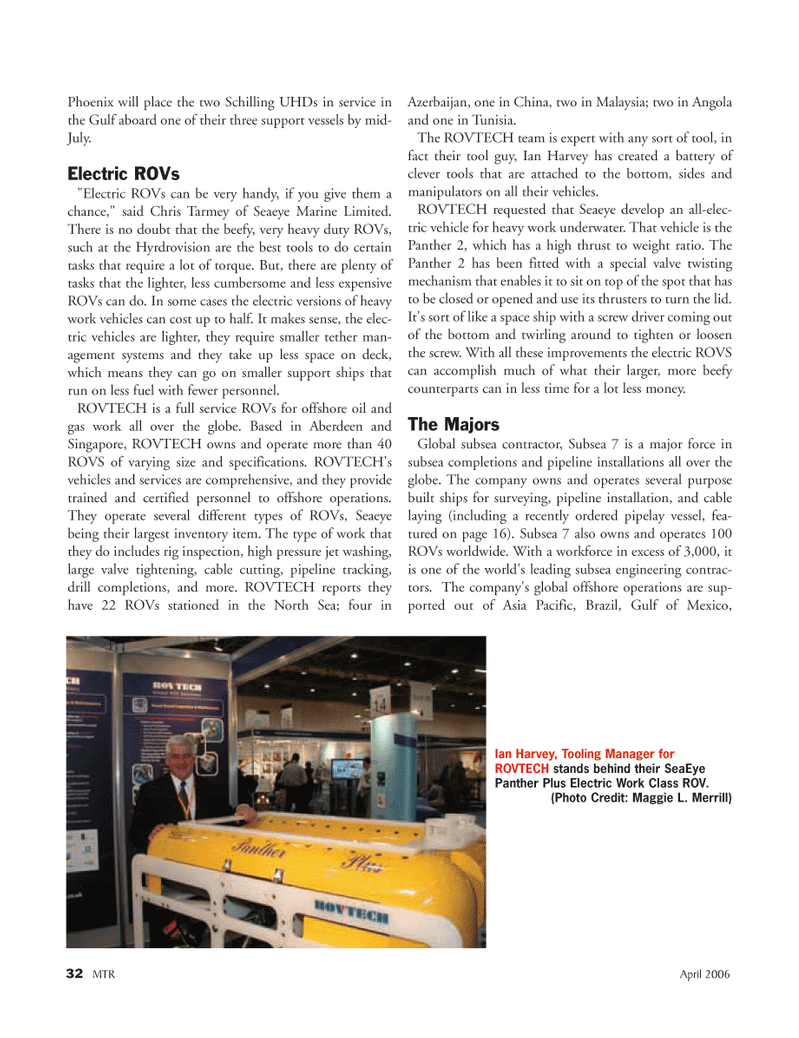
Page 32: of Marine Technology Magazine (April 2006)
The Offshore Technology Edition
Read this page in Pdf, Flash or Html5 edition of April 2006 Marine Technology Magazine
32 MTR April 2006
Phoenix will place the two Schilling UHDs in service in the Gulf aboard one of their three support vessels by mid-
July.
Electric ROVs "Electric ROVs can be very handy, if you give them a chance," said Chris Tarmey of Seaeye Marine Limited.
There is no doubt that the beefy, very heavy duty ROVs, such at the Hyrdrovision are the best tools to do certain tasks that require a lot of torque. But, there are plenty of tasks that the lighter, less cumbersome and less expensive
ROVs can do. In some cases the electric versions of heavy work vehicles can cost up to half. It makes sense, the elec- tric vehicles are lighter, they require smaller tether man- agement systems and they take up less space on deck, which means they can go on smaller support ships that run on less fuel with fewer personnel.
ROVTECH is a full service ROVs for offshore oil and gas work all over the globe. Based in Aberdeen and
Singapore, ROVTECH owns and operate more than 40
ROVS of varying size and specifications. ROVTECH's vehicles and services are comprehensive, and they provide trained and certified personnel to offshore operations.
They operate several different types of ROVs, Seaeye being their largest inventory item. The type of work that they do includes rig inspection, high pressure jet washing, large valve tightening, cable cutting, pipeline tracking, drill completions, and more. ROVTECH reports they have 22 ROVs stationed in the North Sea; four in
Azerbaijan, one in China, two in Malaysia; two in Angola and one in Tunisia.
The ROVTECH team is expert with any sort of tool, in fact their tool guy, Ian Harvey has created a battery of clever tools that are attached to the bottom, sides and manipulators on all their vehicles.
ROVTECH requested that Seaeye develop an all-elec- tric vehicle for heavy work underwater. That vehicle is the
Panther 2, which has a high thrust to weight ratio. The
Panther 2 has been fitted with a special valve twisting mechanism that enables it to sit on top of the spot that has to be closed or opened and use its thrusters to turn the lid.
It's sort of like a space ship with a screw driver coming out of the bottom and twirling around to tighten or loosen the screw. With all these improvements the electric ROVS can accomplish much of what their larger, more beefy counterparts can in less time for a lot less money.
The Majors
Global subsea contractor, Subsea 7 is a major force in subsea completions and pipeline installations all over the globe. The company owns and operates several purpose built ships for surveying, pipeline installation, and cable laying (including a recently ordered pipelay vessel, fea- tured on page 16). Subsea 7 also owns and operates 100
ROVs worldwide. With a workforce in excess of 3,000, it is one of the world's leading subsea engineering contrac- tors. The company's global offshore operations are sup- ported out of Asia Pacific, Brazil, Gulf of Mexico,
Ian Harvey, Tooling Manager for
ROVTECH stands behind their SeaEye
Panther Plus Electric Work Class ROV. (Photo Credit: Maggie L. Merrill)
MTR#3 (17-32).qxd 4/7/2006 11:35 AM Page 32

 31
31

 33
33
